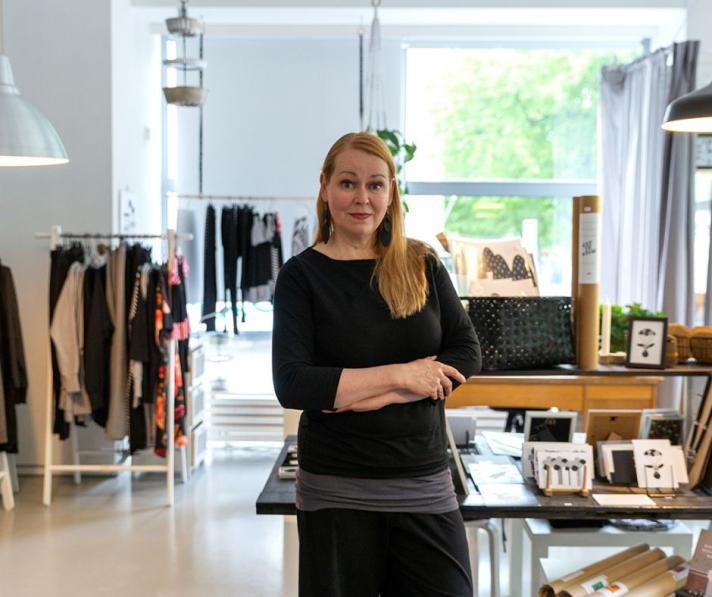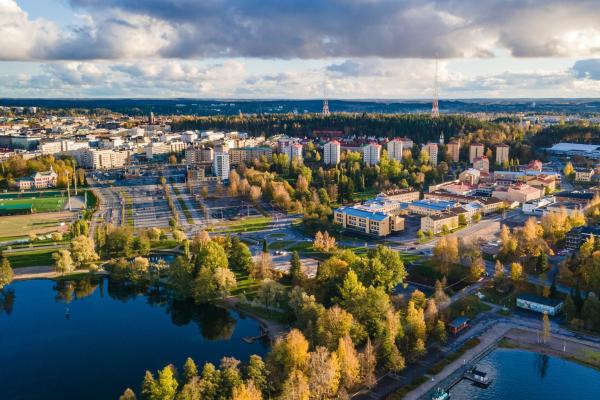Riikka has experience in both domestic production and outsourcing. After graduating as a fashion designer, she started working for big brands and became familiar with the working conditions in the clothing industry around the world.
“I travelled a lot when I was young and saw clothing factories in Southern Europe, the Baltic countries and the Far East. I realised then that it’s very difficult to monitor working conditions or quality in faraway countries, despite the certificate a company has.”
In 2012, Riikka decided to break away and join a Finnish clothing company to help build their brand and ensure its sustainable production. Five years later, in 2017, she was ready to start building her own ‘Cocoonhouse’ collection.
“I wanted to do things responsibly. I set out to build a domestic brand. I wanted to build a production system with quality, ethics, and ecology as the driving forces. My own Cocoon collection is made almost entirely in Lahti, from materials that are ecologically-sustainable and mainly domestic”.
One of Riikka’s solutions is to design quality items that don’t go out of fashion quickly. The same trouser design can be included in the collection for years, with only the colours and prints changing.
“This means that the customer can count on the fact that, even two years later they will still be able to buy trousers that fit well and that they love. I have received a lot of supportive and positive feedback about my minimalist products.”
Riikka’s work helps to support the EU Circular Economy Action Plan. Textiles are currently the fourth highest-pressure category for using primary raw materials and water; and fifth for greenhouse gas emissions. The EU Circular Economy Action Plan approach to textiles aims to strengthen industrial competitiveness and innovation in the textile sector. This will boost the EU market for sustainable and circular textiles, including the market for textile reuse, while addressing fast fashion and driving new business models too.
Quality is ensured with sustainable and ecological materials, most of which are manufactured within Europe. This approach to fostering EU production helps to sustain jobs and reducing supply chain emissions by shifting away from a global supply chain.
“Our certified linen comes from the Baltic countries and our knitted fabric is from merino wool made in Finland, although the yarn itself is not available here. We purchase certified organic cotton, which is being replaced more and more by wood-based tencel fibre, also available in Finland.”
Local network is a lifeline
Cocoonhouse operates in Lahti and relies on its “cooperation network”. Products are sewn by eight dressmakers in three sewing shops, one of which is a cooperative. Riikka wants to develop the skills of other entrepreneurs too and she acts as sponsor for the cooperative.
“There used to be an excellent, thriving textile and clothing industry here in Lahti, and luckily some of the expertise still remains. However, entrepreneurship has changed since the big factories’ reign, which means that things have to be done differently now.”
When creating new production lines, Riikka believes in the power of skilled workers. For example, in 2020, after the coronavirus pandemic broke out, she helped another company research facemask production. Such small businesses can strive to respond to unexpected situations in the future too
Clothing production in Finland is profitable
Talking about money is also important to Riikka. She wants to break the myth that says companies cannot have clothes manufactured in Europe because of the high labour costs. In addition to its brick-and-mortar shop, Cocoonhouse’s products are also sold in its online store.
“My dressmakers get paid, as do I, even though my clothes are not the most expensive on the market. But I do carefully consider the kind of profit margin generated at each stage of production,” she says.
Discover all the Citizen Diaries from Lahti

Valtteri Bottas began his career when he was just six years old, racing karts in his hometown of Nastola in Finland.

In the winter of 2016, Eetu Floor was walking to a friend’s band practice in Lahti. On his way there, he chose a shortcut through the industrial area of Sopenkorpi where he found an overgrown industrial track and plot.

The Lahti Pelicans is a Finnish professional ice hockey team that plays for the City of Lahti, in the ‘Liiga’, Finland’s top professional ice hockey league.

Emmi Valli-Forsback from Lahti buys almost all of her family’s clothing and household goods second-hand; and rents a market stall to sell on what she no longer needs. She rarely considers buying something new if she can find it second-hand.

Bee doctor Kamran Fakhimzadeh knows what a miracle honey is: to produce a kilo of it, bees have to visit up to ten million flowers. At the same time, bees do us a huge favour by pollinating vegetables and fruit and berry plants.

Rikka-Liisa Aalto has always picked up litter in her local area. After becoming a mother, she started picking up litter almost every day. The Puhdas Päijät-Häme network was born out of a desire to make a connection with other people who care about the environment.

In 2015, in celebration of the 150th anniversary of the Sibelius Hall, the Lahti Symphony Orchestra initiated a project to help the City of Lahti reach its carbon emission reduction goals.

Fashion designer and entrepreneur Riikka Flink has been observing the clothing industry for over 30 years. She believes that ecology, sustainability, and responsibility are possible when production is closely monitored.


